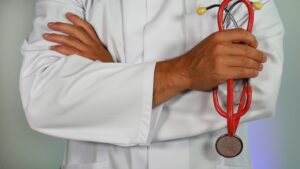WHAT IS JAUNDICE?
The word “jaundice” comes from the French word jaune, which means yellow.
Jaundice is a yellowish staining of the skin, the whites of the eyes, and mucous membranes by bilirubin, a yellow-orange bile pigment. Bilirubin (read more about it here!) comes mainly from the breakdown of red blood cells, and is basically a waste product that your liver gets rid of.
Jaundice usually appears when the bilirubin in your blood is more than 3 mg per dL (51.3 µmol per L). The classic definition of jaundice is a serum bilirubin level greater than 2.5 to 3 mg per dL (42.8 to 51.3 µmol per L) as well as having yellow skin and eyes.
Your body processes bilirubin in 3 phases: prehepatic (before it gets to the liver), intrahepatic(whilst in the liver), and posthepatic(after leaving the liver). If any of these aren’t working properly you can become jaundiced.
PREHEPATIC
The human body produces about 4 mg per kg of bilirubin per day, from the breakdown of blood cells. Bilirubin is then transported from to the liver for conjugation (where it needs to link up with other enzymes and chemicals so that it can be removed from the body) .
INTRAHEPATIC
Unconjugated bilirubin (the bilirubin that hasn’t been removed by linking up with an enzyme) doesn’t dissolve in water but is soluble in fats. That means it can easily cross the blood-brain barrier or enter the placenta. The unconjugated bilirubin is conjugated (linked up with) with a sugar via the enzyme glucuronosyltransferase (the enzyme that people with GS don’t have enough of) and is then soluble in the bile.
POSTHEPATIC
Once soluble in bile, bilirubin is transported through to the gallbladder, where it is stored, or passed on to the duodenam. Inside the intestines, some bilirubin is excreted in the stool, while the rest is dealt with by the bacteria in your gut.
JAUNDICE AND OTHER SYMPTOMS
Some people with jaundice have no symptoms at all. But some may have an acute illness, which is frequently caused by infection, may seek medical care because of fever, chills, abdominal pain, and flu-like symptoms. For these patients, the change in skin color may not be their greatest concern!
Patients with noninfectious jaundice may complain of weight loss or itching / skin discomfort. Abdominal pain is the most common symptom in patients with pancreatic or biliary tract cancers.Even something as nonspecific as depression may be a symptom in patients with chronic infectious hepatitis and in those with a history of alcoholism.
‘False’ jaundice can happen if you eat foods rich in beta-carotene (e.g., squash, melons, and carrots). Unlike true jaundice, you don’t get yellow eyes, or changes in bilirubin level.
CAUSES OF JAUNDICE:
PREHEPATIC CAUSES
Unconjugated hyperbilirubinemia (this is when you’ve too much bilirubin in your bloodstream because it’s not been processed in the liver, as in Gilbert’s Syndrome) might happen before bilirubin has entered the liver cells or within the liver cell. If you’ve had an unusual breakdown in your red blood cells then there may be too much of the waste product, bilirubin, for your liver to process as normal.
This will usually result in mild bilirubin elevation, to about 5 mg per dL (85.5 µmol per L), with or without clinical jaundice. The blood might be breaking down because of a number of causes in the blood cells or your enzymes which mean your red cells have stayed alive longer than normal, and built up. Other causes include autoimmune disorders, drugs, and defects in hemoglobin structure such as sickle cell disease and the thalassemias.
INTRAHEPATIC CAUSES
Un-Conjugated Hyperbilirubinemia Gilbert syndrome is a common, benign, hereditary disorder that affects approximately 5 percent of the U.S. population. It usually results in a mild decrease in the activity of the enzyme glucuronosyltransferase. Gilbert syndrome is typically an incidental finding on routine liver function tests, when the bilirubin level is slightly increased and all other liver function values are within normal limits. Jaundice and further elevation of the bilirubin level may occur during periods of stress, fasting, or illness.
Conjugated Hyperbilirubinemia. Main causes are when there’s a blockage preventing bilirubin from moving into the intestines. Viruses, alcohol, and autoimmune disorders are the most common causes of hepatitis. Inflammation also disrupts transport of the bilirubin and causes jaundice.
Hepatitis A can cause acute onset of jaundice. Hepatitis B and C infections often do not cause jaundice straight away, but can lead to jaundice when chronic infection has led to liver cirrhosis. Epstein-Barr virus infection occasionally causes hepatitis and jaundice that resolve as the illness clears.
Alcohol has been shown to affect bile acid uptake and secretion, stopping the normal flow through the liver. Chronic alcohol use may result in fatty liver (steatosis), hepatitis, and cirrhosis, with varying levels of jaundice. Fatty liver, the most common liver problem, usually results in mild symptoms without jaundice but occasionally progresses to cirrhosis. Hepatitis secondary to alcohol use typically presents with acute onset of jaundice and more severe symptoms.
More rare conditions that can cause jaundice: Autoimmune hepatitis traditionally has been considered a disease that affects younger persons, especially women. Two serious autoimmune diseases that directly affect the biliary system without causing much hepatitis are primary biliary cirrhosis and primary sclerosing cholangitis. Primary biliary cirrhosis is a rare progressive liver disease that typically presents in middle-aged women. Fatigue and itching / skin discomfort are common initial complaints, while jaundice happens later. Primary sclerosing cholangitis, which is also rare, is more common in men; nearly 70 percent of patients also have inflammatory bowel disease. Dubin-Johnson syndrome and Rotor’s syndrome are rare hereditary metabolic defects that disrupt transport of conjugated bilirubin.
Common drugs can also cause problems, such as acetaminophen, penicillins, oral contraceptives, anti-psychotic medication, and steroids. Cholestasis can develop during the first few months of oral contraceptive use and may result in jaundice.
POSTHEPATIC CAUSES
Gallstones in the gallbladder are fairly common in adults. Obstruction within the biliary duct system can inflame the gallbladder, and can lead to infection. Cholangitis is diagnosed clinically by the classic symptoms of fever, pain, and jaundice, known as Charcot’s triad. Cholangitis most commonly occurs because of an impacted gallstone, which might then be removed.
Biliary tract tumors are uncommon but serious causes of posthepatic jaundice. Gallbladder cancer classically presents with jaundice, enlarged liver, and a mass in the right upper quadrant (Courvoisier’s sign). Another biliary system cancer, cholangiocarcinoma, typically manifests as jaundice, itching / skin discomfort, weight loss, and abdominal pain. It accounts for roughly 25 percent of hepatobiliary cancers.
Jaundice also may arise with pancreatitis. The most common causes of pancreatitis are gallstones and alcohol use. Gallstones are responsible for more than one half of cases of acute pancreatitis, which is caused by obstruction of the duct that drains the biliary and pancreatic systems.
Evaluation
The initial work-up of the patient with jaundice depends on whether the hyperbilirubinemia is conjugated (direct) or unconjugated (indirect). A urine anlysis that is positive for bilirubin indicates the presence of conjugated bilirubinemia. Conjugated bilirubin is water soluble and so passed through urine.
SO IF YOU’RE JAUNDICED WHAT DO THEY DO TO WORK OUT WHAT’S CAUSING IT? Here’s the clinical information :
BLOOD TESTING
First-line serum testing in a patient presenting with jaundice should include a complete blood count (CBC) and determination of bilirubin, aspartate transaminase (AST), alanine transaminase (ALT), gamma-glutamyl transpeptidase, and alkaline phosphatase levels.
Depending on the results of the initial tests, further serum tests or imaging studies may be warranted. The second-line serum investigations may include tests for hepatitis A IgM antibody, hepatitis B surface antigen and core antibody, hepatitis C antibody, and autoimmune markers such as antinuclear, smooth muscle, and liver-kidney microsomal antibodies. An elevated amylase level would corroborate the presence of pancreatitis when this condition is suspected based on the history or physical examination.
IMAGING
Ultrasonography and computed tomographic (CT) scanning are useful in distinguishing an obstructing lesion from hepatocellular disease in the evaluation of a jaundiced patient. Ultrasonography is typically the first test ordered, because of its lower cost, wide availability, and lack of radiation exposure, which may be particularly important in pregnant patients. While ultrasonography is the most sensitive imaging technique for detecting biliary stones, CT scanning can provide more information about liver and pancreatic parenchymal disease. Neither is good at finding stones inside the ducts.
Further imaging that may be done by a gastroenterologist or interventional radiologist includes endoscopic retrograde cholangiopancreatography and percutaneous transhepatic cholangiography.
LIVER BIOPSY
A liver biopsy provides information on the architecture of the liver and is used mostly for determining prognosis. It also may be useful for diagnosis if serum and imaging studies do not lead to a firm diagnosis. Liver biopsy can be particularly helpful in diagnosing autoimmune hepatitis or biliary tract disorders (e.g., primary biliary cirrhosis, primary sclerosing cholangitis).


Hi,
I’ve just been diagnosed with GS. I’m 28 years old. I eat a vegetarian diet, low in carbs and high in fruit and vegetables. I drink lots of water and tea and try to only drink alcohol 2 times a week (2-4 units a week). I go out for daily walks and do yoga 3 times a week.
However, my eyes often have a yellowish tinge to them which I feel really aware of and embarrassed about. Do you have any experience of this? Or any advice on what I could do to lower my bilirubin further?
Many thanks 🙂